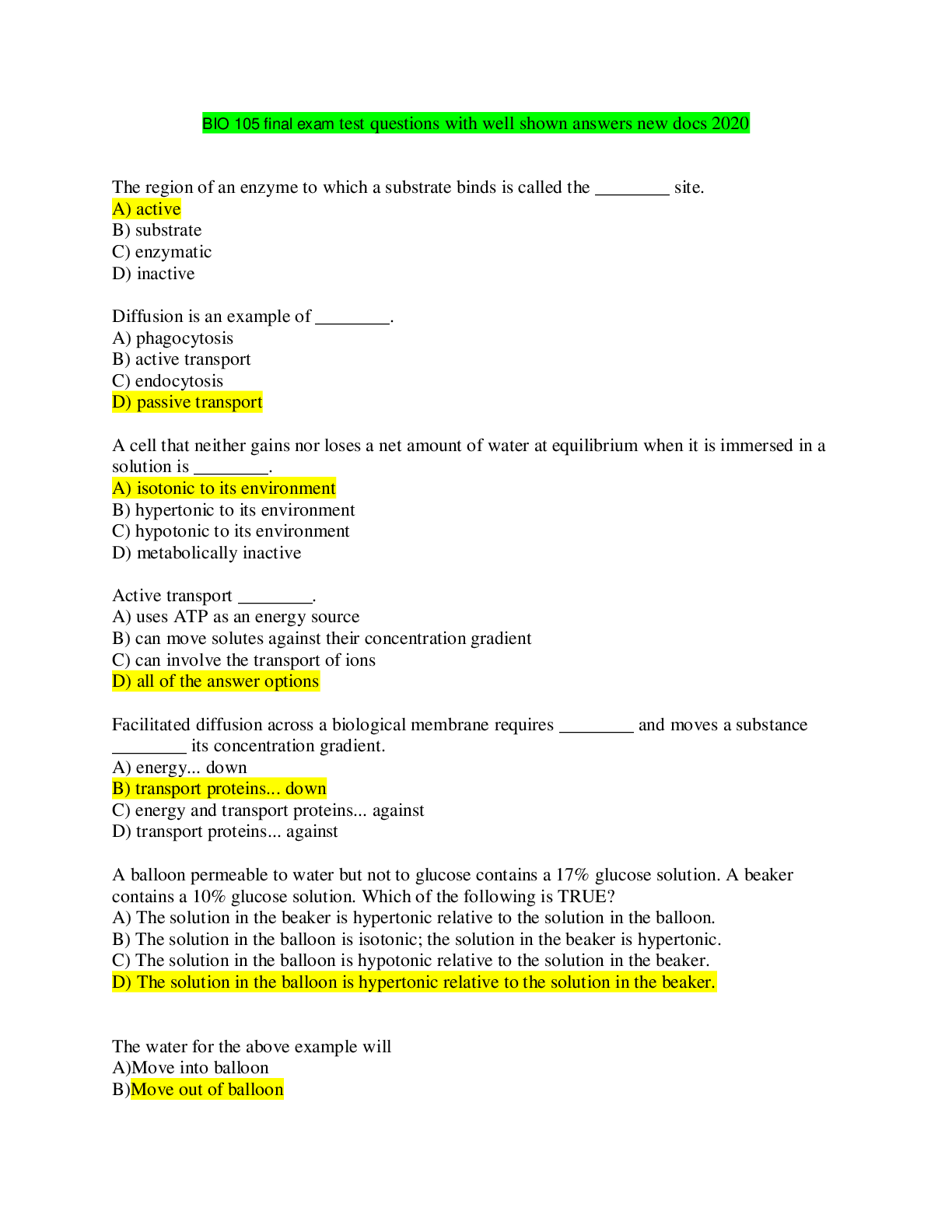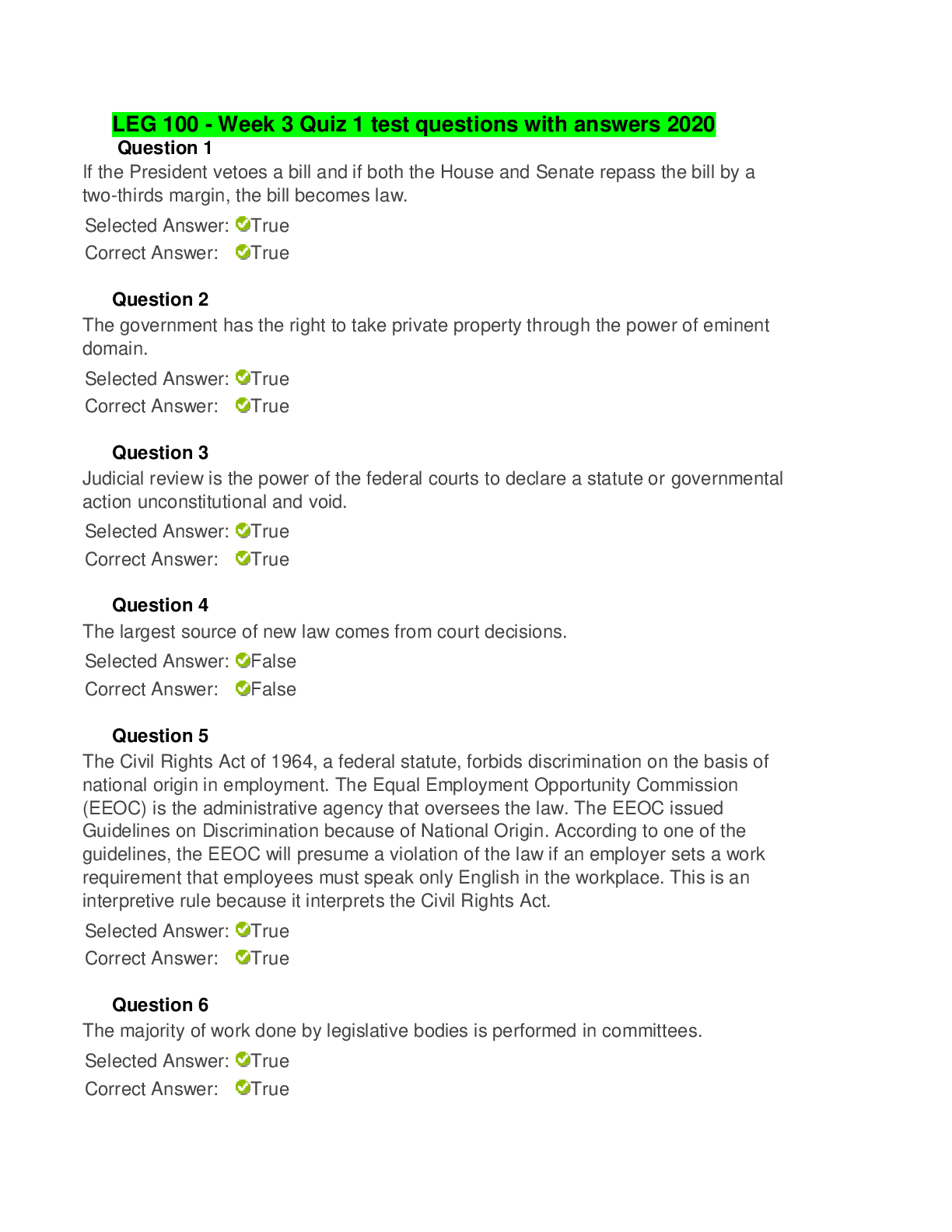*NURSING > QUESTIONS & ANSWERS > TCCC Pre test questions with accurate answers. Rated A+. 2022/2023. (All)
TCCC Pre test questions with accurate answers. Rated A+. 2022/2023.
Document Content and Description Below
Which of the following is a principle of TCCC? a. Treat the casualty b. Prevent additional casualties c. Complete the mission d. All of the above - ✔✔d Which of the following is NOT one of... the three phases of care in TCCC? a. Care Under Fire b. Tactical Field Care c. Tactical Evacuation Care d. Combat Life Saving Care - ✔✔d The preferred analgesia regimen for someone who has wounds that are moderately painful but not life threatening and that do not keep him from functioning effectively as a combatant is: a. Morphine IV b. Morphine IM c. Mobic and Tylenol ER d. Aspirin - ✔✔c The most common cause of preventable death on the battlefield is the failure to use a tourniquet to control severe extremity bleeding. - ✔✔T The best battlefield indicators of shock during Tactical Field Care are: a. Heart rate and face color b. State of consciousness and quality of the radial pulse c. Rapid heart rate d. None of the above - ✔✔b All combat casualties should have an IV started as soon as possible. - ✔✔F A casualty has sustained a gunshot wound to the chest. He/she should be allowed to take fluids by mouth if able to. - ✔✔T Administering large quantities of fluids to a casualty who has bleeding sites inside the chest or abdomen may worsen his or her hemorrhage by diluting clotting factors or by interfering with clot formation at the bleeding site. - ✔✔T Antibiotics are recommended for all combat casualties who sustain open wounds. - ✔✔T Which of the following is NOT appropriate to the Care Under Fire phase? a. Starting an IV b. Controlling life-threatening extremity bleeding with a tourniquet c. Returning fire as necessary d. All of the above - ✔✔a To be most effective at preventing infections, moxifloxacin should be given when after wounding? a. As soon as possible b. Whenever c. Within 4 hours d. None of the above - ✔✔a What is the next step in airway management for a corpsman who has just used the chin-lift/jaw-thrust method to successfully open the airway of a casualty who is unconscious from a blast injury during the Tactical Field Care phase? a. Nasopharyngeal airway b. Surgical airway c. Tracheal intubation d. None of the above - ✔✔a As a corpsman you are confronted with the following three casualties. Which one should be cared for first? a. Casualty A - shot in the head and unconscious b. Casualty B - shot in the abdomen - awake and alert c. Casualty C - heavy bleeding from a thigh wound - ✔✔c The ideal management of a casualty in a combat setting is not necessarily the same as for the identical injury in a civilian setting. - ✔✔T The Tactical Combat Casualty Care guidelines presented in this course should not be modified no matter what the tactical context in which the casualties occur is. - ✔✔F A casualty has suffered a gunshot wound to the chest. As you watch him, he is having more and more trouble with his breathing. What is the best next step? a. Tracheal intubation b. Put in a chest tube c. Needle decompression for a suspected tension pneumothorax - ✔✔c A casualty has sustained a gunshot wound to the face. He is conscious and maintaining his airway by sitting up and leaning forward. A corpsman arrives on the scene. How should the casualty's airway be managed? a. Place him in the supine position and intubate him b. Allow him to continue to sit up and lean forward as care is rendered c. Perform a surgical airway d. None of the above - ✔✔b What is the best quick check for an adequate airway? a. Ask a question that requires a response from the casualty b. Check for a bluish color of the nail beds c. Determine the casualty's respiratory rate d. Auscultate the chest - ✔✔a The minimum amount of time in which a casualty could bleed to death from a femoral (thigh) wound with heavy bleeding is approximately: a. 3 minutes b. 10 minutes c. 15 minutes d. 30 minutes - ✔✔a A casualty who has lost a liter of blood is in danger of dying from hemorrhagic shock. - ✔✔F What level of blood loss is likely to be associated with death from hemorrhagic shock? a. 0.5 liters b. 1.0 liter c. 1.5 liters d. 2.5 liters e. None of the above - ✔✔d The preferred antibiotic in the Tactical Field Care phase is moxifloxacin. This medicine is preferred because it: a. Is effective against most bacteria b. Has a relatively mild side effect profile c. Can be taken by mouth d. Is inexpensive e. All of the above - ✔✔e Giving a rapid infusion of IV fluids to casualties with uncontrolled bleeding (such as casualties with wounds of the chest or abdomen) was shown to increase the mortality rate in the largest study done to date on this issue. - ✔✔T Which of the following three casualties has the greatest need for an emergent CASEVAC: a. A casualty who stepped on a land mind and has a traumatic amputation of the leg at the knee with bleeding controlled by a tourniquet. b. A casualty who was shot in the head and is unconscious with a significant amount of brain tissue exposed. c. A casualty who was shot in the abdomen and who now has an absent radial pulse. - ✔✔c What is the most important thing to do after splinting an open fracture? a. Check to ensure that the pulses distal to the splint have not been reduced by the splint b. Check to ensure that the extremity is completely covered by wrapping material used in splinting c. Check to ensure that the extremity is in perfect alignment d. None of the above - ✔✔a Which of the following is a good reason NOT to give casualty morphine? a. His wounds are minor and he can continue to fight b. He is in shock c. He has a chest wound and is in respiratory distress d. All of the above - ✔✔d Which of the following is true? a. Extremity hemorrhage is the most frequent cause of preventable battlefield deaths b. Most combat fatalities die from airway problems c. Life-threatening extremity bleeding is treated in the Care under Fire phase is treated with Combat Gauze d. None of the above - ✔✔a You are treating a casualty with a gunshot wound to his lower jaw which severely disrupts the oropharyngeal anatomy. He suddenly develops complete airway obstruction, struggles briefly, and loses consciousness. What is the airway intervention of choice at this point? a. Nasopharyngeal airway and recovery position b. Endotracheal intubation c. Surgical airway d. Sit the casualty up and attempt two rescue breaths - ✔✔c After a brief skirmish with the enemy 10 minutes ago, your unit is holding temporarily in a secure area. During the firefight, you sustained a gunshot wound to your right thigh that produced heavy arterial bleeding. You initially controlled the hemorrhage by applying your own tourniquet. There are no other medics in your unit, and the CASEVAC helicopter will arrive at your location in one-half hour. The MTF is 10 minutes away by air. Which is the best strategy for dealing with the tourniquet on your leg? a. Replace the tourniquet with a Combat Gauze dressing b. Replace the tourniquet with WoundStat and direct pressure c. Construct a pressure dressing over your leg wound, and remove the tourniquet yourself d. Leave the tourniquet in place - ✔✔d Which of the following statements is true? a. Casualties who are alert and can swallow should not be allowed to take fluids by mouth. b. The F.A.S.T.-1 intraosseous device is a good way to obtain vascular access for a casualty in whom an IV cannot be started. c. Pulse oximetry and other electronic monitoring are not useful during Tactical Evacuation Care in a helicopter. d. All combat wounds produce severe pain. - ✔✔b Regarding the provision of care to hostile combatants, which of the following statements are true? a. Wounded hostile combatants may still inflict deadly force on you and your unit. b. No care is to be rendered until the wounded hostile combatant has dropped all weapons, indicated that he wishes to surrender, and been searched and secured by the unit prisoner handlers. c. Once secure, the same care should be rendered to the POW as accorded U.S. and friendly forces. d. All of the above are true - ✔✔d Fluid resuscitation to treat shock is not considered a part of Care Under Fire. - ✔✔T Moxifloxacin requires only once-a-day dosing. - ✔✔T Why is Hextend preferred over normal saline or Lactated Ringer's for combat casualties who often have a prolonged delay to evacuation? a. It's cheaper b. It's made by Halliburton c. The intravascular volume expansion lasts much longer than that achieved with normal saline or Lactated Ringer's d. None of the above - ✔✔c Which of the following is NOT part of the nine-line evacuation request? a. Pick-up location b. Ages of the casualties c. Number of casualties to be evacuated d. Special equipment required - ✔✔b Which of the following is NOT an advantage of fentanyl lozenges over morphine in the tactical setting? a. No need to start an IV to administer b. Works faster than IM morphine c. No potential for respiratory depression d. All of the above are true - ✔✔c One correct landmark for performing a needle decompression (on the side of the chest with the penetrating trauma) is: a. Second intercostal space, mid-clavicular line b. Second intercostal space, mid-axillary line c. Fourth intercostal space, mid-clavicular line d. Fourth intercostal space, mid-axillary line - ✔✔a In a tactical environment, the initial treatment of choice for stopping severe distal extremity hemorrhage is: a. Direct pressure b. Pressure point compression c. A pressure dressing d. A tourniquet - ✔✔d A Combat Gauze dressing is used for: a. Control of severe external bleeding b. Abdominal wounds without severe ext [Show More]
Last updated: 3 years ago
Preview 1 out of 22 pages
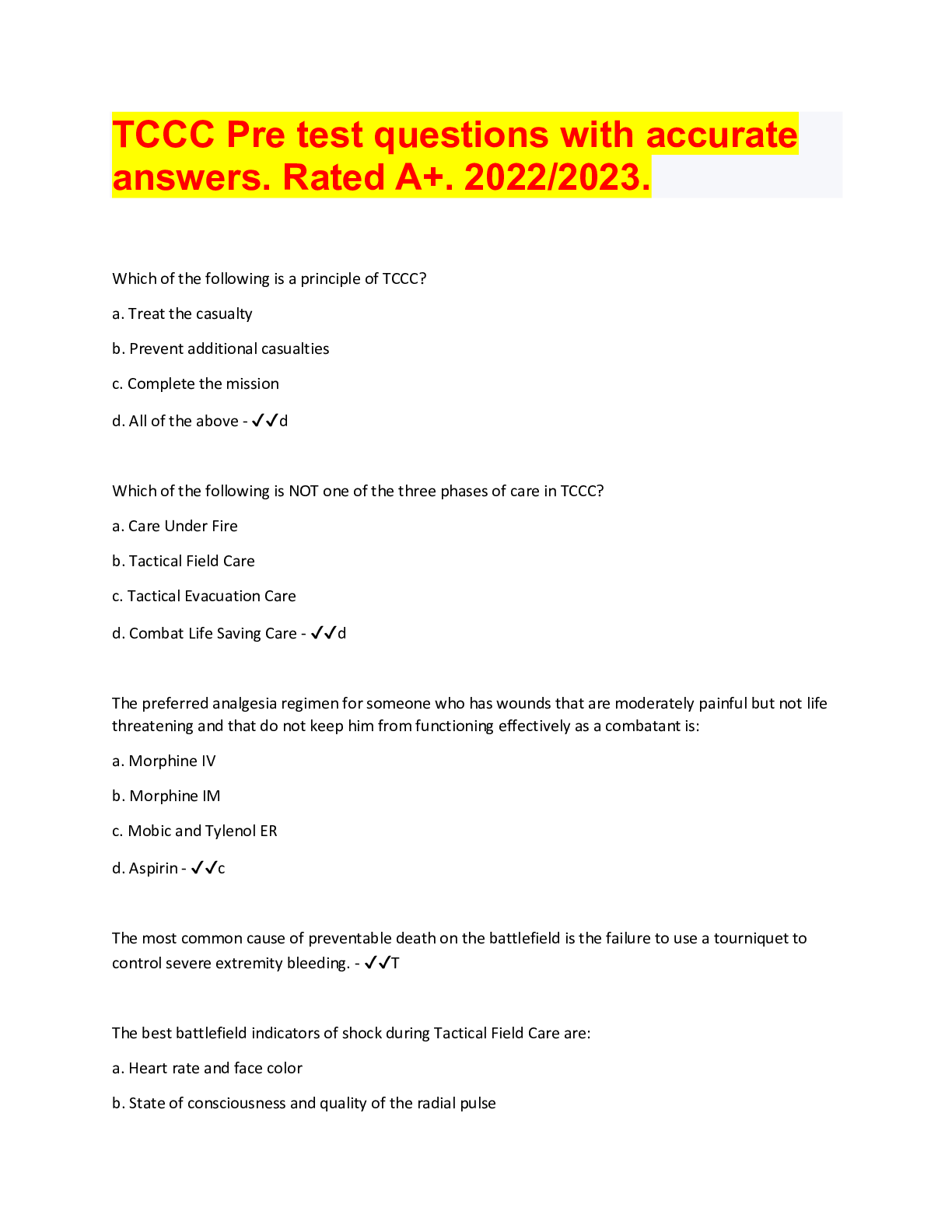
Buy this document to get the full access instantly
Instant Download Access after purchase
Buy NowInstant download
We Accept:

Reviews( 0 )
$10.00
Can't find what you want? Try our AI powered Search
Document information
Connected school, study & course
About the document
Uploaded On
Aug 14, 2022
Number of pages
22
Written in
Seller

Reviews Received
Additional information
This document has been written for:
Uploaded
Aug 14, 2022
Downloads
1
Views
239














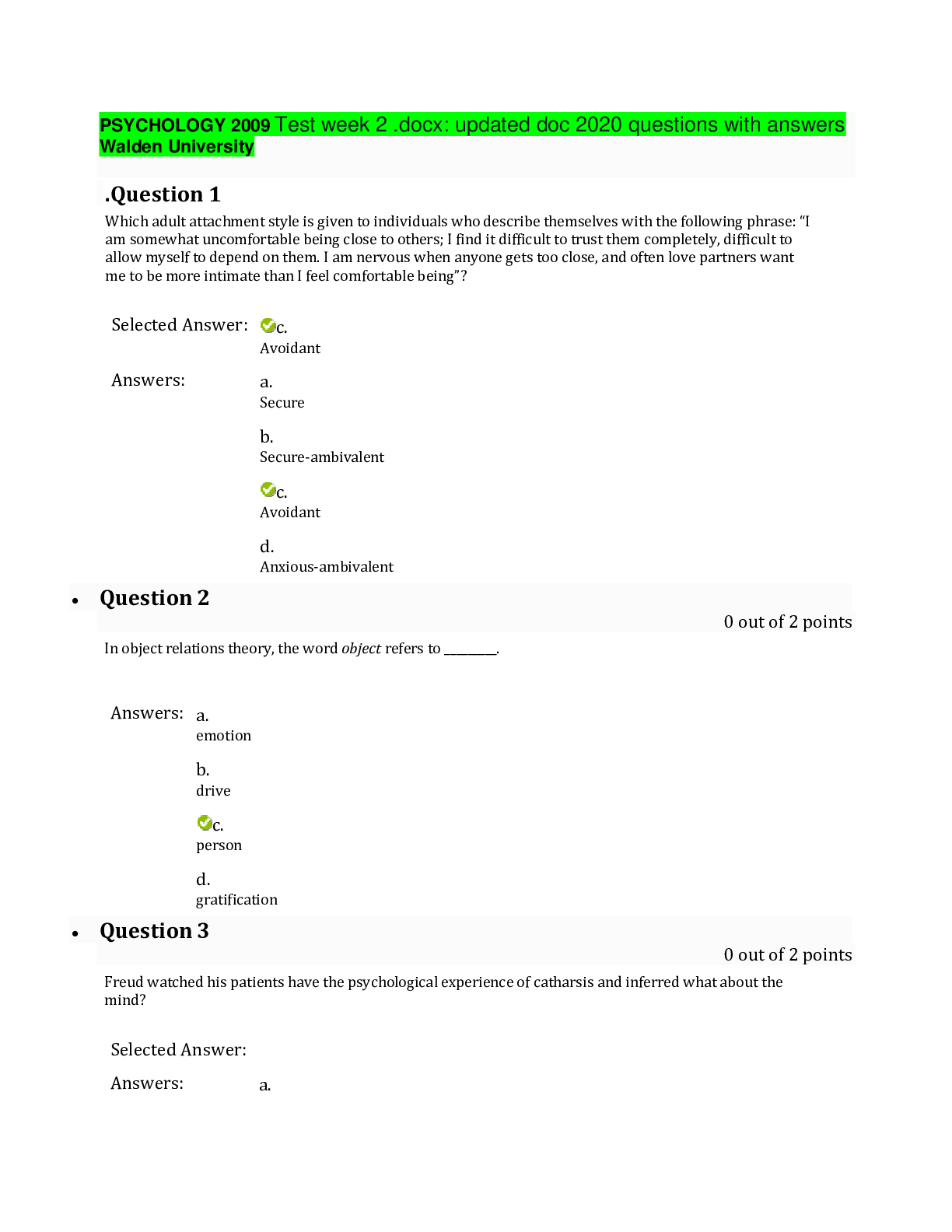

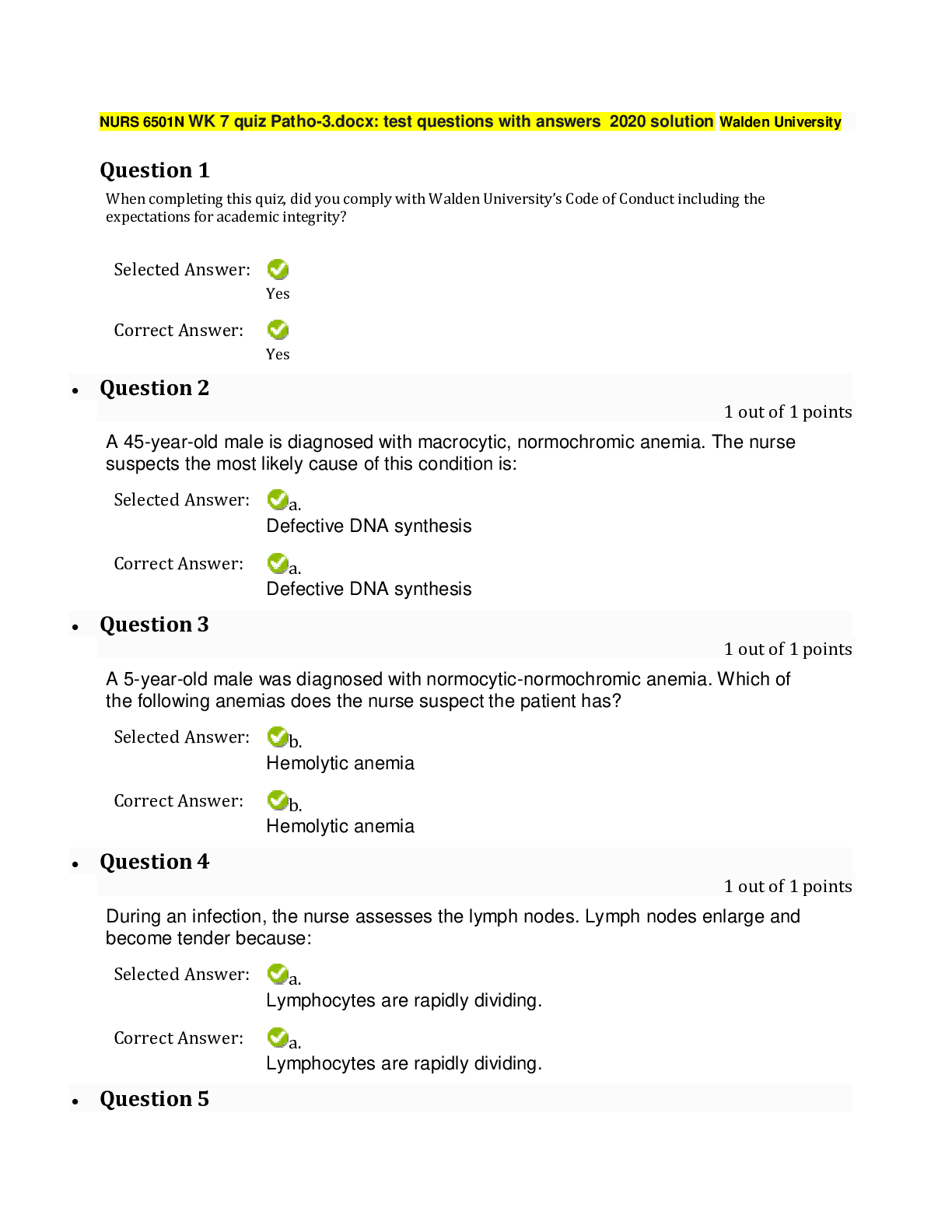

.png)

.png)
.png)
